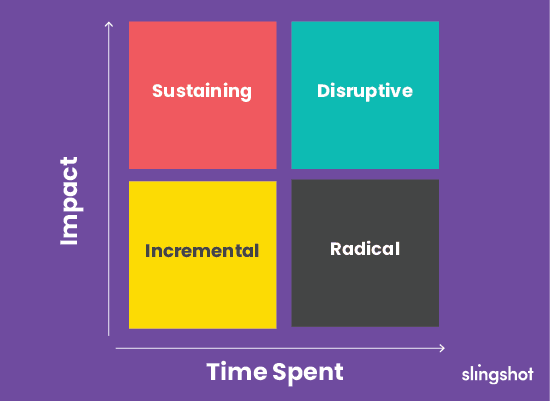Change is… tricky, right? A lot of people hate change, and will go out of there way to avoid it. Whether it’s because we like where were at, the fear of losing control, or simply because it takes a lot of effort, adjusting to something new can be scary.
Now think to your business: whether you’re entry level or the CEO, change in business is necessary to stay ahead of the game (but can suck, too.) Innovation can be tricky, confusing, and cumbersome for a team that’s never done it before.
Change is… tricky, right? A lot of people hate change, and will go out of there way to avoid it. Whether it’s because we like where were at, the fear of losing control, or simply because it takes a lot of effort, adjusting to something new can be scary.
Now think to your business: whether you’re entry level or the CEO, change in business is necessary to stay ahead of the game (but can suck, too.) Innovation can be tricky, confusing, and cumbersome for a team that’s never done it before.
So how do you make innovation fun and interesting if you’ve never done it before? Dive on into this week’s article, where we’ll be discussing all the whys, how’s, and what’s surrounding business innovation.
So how do you make innovation fun and interesting if you’ve never done it before? Dive on into this week’s article, where we’ll be discussing all the whys, how’s, and what’s surrounding business innovation.
Summary
Innovation is anything your business changes to try and better itself. Companies need to innovate so that they can grow, stay profitable, and keep customers happy. You can focus on small changes that will add up over time, or a massive change that will change the industry.
While there’s no one perfect way to foster innovation, some tips include: reward your team’s failures, create a safe and collaborative environment, find people who care, and lean into risk and news-ness.
What Does Innovation Mean?
Innovation is (basically) any new change to a business. As you can imagine, this can be a lot of different things (which we talked about in our Innovation in Louisville blog). Innovation can be as small as a new idea, or as big as an entirely new way of doing business. Products, services, models, and concepts, oh my!)
The best way to look at innovation IMO is to see change as an opportunity rather than a risk or threat.

Why is Innovation Important?
It’s cheesy, but we wouldn’t be where we are today without innovation. Had we stopped at the latest best new thing, we’d be missing out on quite a bit. For example, cars. Had we stopped advancing once we created the horse and buggy, society would still be getting around on four hooves rather than 4 wheels.
But that’s society as a whole, right? Why do my company and I have to be innovative? We’re glad you asked; here’s a handful of reasons why innovation is important in business:
Growth
It’s pretty hard to grow as a company if you don’t change anything. Sure, you can stay where you are, but there can’t be upward moment without mixing things up. Best case scenario, you stay where you are. More often than not, though, you’ll begin falling behind.
Efficiency
Innovation doesn’t always have to be a new idea from out of nowhere. Some of the best and most effective innovations have improved on things we already have. Look at your current process or product: you can probably find ways to improve these without creating something that doesn’t exists.
Related Article: Time’s Effect on Cost in Development
Profit
This is the big one, right? If you create a company that’s innovative, you’ll have a company that’s more likely to be profitable. Pivoting with changing trends, always open to new ideas: that sounds like a successful company. And that leads to profit.
Models of Innovation
We promise this won’t be like your textbooks form school; we’re not going to drone on about definitions and comparison (much less test you on them). But, it’s still good to know the different ways innovation can be broken down.
Revenue |
Business |
Industry |
| This one is similar to Low Hanging Fruit: where are we currently missing out on revenue? This could be offering new product to meet a new need, or removing services that no longer serve your customers. | Getting bigger now: the business model of innovation has you look at your process and strategy. What internally can we change that will benefit our company? One example could be hiring a CIO to create a technology mindset. | Now step aaaallll the way back. For Industry innovation, you’ll want to look at the entire market, and see where there are missing pieces. While it is the riskiest, it also return the highest reward. |
So that was innovation from a size perspective. What about innovation that compares time spent to impact? That’s a specific question, but were glad you asked!
Incremental
We’re back to our low hanging fruit analogy: this is the least risky form of innovation. You’ll gradually make changes to an existing product over time. Most companies do this without realizing it. Have you ever tweaked something in your service? Boom: you’ve used incremental innovation!
Sustaining
Just like incremental, we’re making changes to a product or service that already exists. However, instead of gradually making small updates overtime, you’ll make one or two massive changes. While this takes longer then incremental to see the benefit, it does offer more return.

Disruptive
This is what most people think of when they hear innovation: a new product or service that changes an industry as we know it. You’re disrupting (get it!) the way business is done by creating a new product, service, strategy, or culture.
Radical
Like Incremental, this is lot of smaller changes that happen overtime. The difference, however, is radical innovation is like a domino effect: lots of new-ness that piles up until the market is disrupted.
How to Foster Innovation
We made it – the reason you’re here! Now that you know what innovation is, why it’s important, and the different ways you can get there, let’s take a look at some tips on how you can make your company an innovative one.
Reward Failure as much as Success
Almost everyone’s more open to rewarding success: it’s easier to see and and should be celebrated. But if you want to keep your company innovating, you need to make sure you’re rewarding failures to. Trying is the only way to find new paths, and if your team gets discouraged after one wrong turn, you won’t be making it far.

Create a Space for Innovation
As you can probably tell, innovation can’t come out of nowhere; there needs to be a process in place. Whether it’s an idea thinking process, a viability test, or just a timeslot to brainstorm, you’ll need some kind of structure or platform for innovative thinking
Remove Seniority Barriers
We have removed a lot of hurdles when it comes to seniority at Slingshot: a junior dev can push back on ideas from Dave, and know that that idea will be heard and through through. The same needs to go for your innovation team: work on breaking down any barriers that would cause someone to not get involved or share their thoughts.
Find Passionate People
You can teach a lot in business, but passion and drive is not one. When thinking about who you’re going to bring to the innovative table, make sure you’re looking for people who are not only passionate about innovation, but also the success of their team and company. If your team is personally invested, you’re more likely to see results.
Create Creativity
Innovation can’t come from getting everyone in a room and waiting for an idea. Being creative and exploratory sometimes needs a little push. You may need a prompt or goal to start things off; this lets people understand what they’re trying to achieve and work towards a specific milestone.
Don’t Just Think, but Look Outside the Box
We all know the innovative-thinking phrase of ‘Think Outside the Box,’ meaning that you should look at your problems from an outsiders perspective. But you don’t have to solely lean on your existing team; there are several companies and people that exist to help others innovate. Think consultants, guest speakers, or educators that can help shed light on a new perspective.

Problem over Profit
Tying into our Create Creativity tip, you should have your innovation team focus on a specific problem or goal rather than simply ‘Raising Profits.’ You can find a lot more opportunity when you think on problems to solve as opposed to just new products.
Love the Unknown
Innovation is risky and experimental. You’ll never be able to dive into an innovative project with 100% certainty that it will succeed. But that’s the fun part about trying to change: you never know where you’re going to end up until you’re there. Don’t be afraid of failure!
Conclusion
Now that you’ve read all the in’s and out’s of innovating, how do you feel about change now: less fearful or anxious? If you answers yes, that’s great to hear! If you answered no, reread until desired results 😉
Remember: change in business is important for growth and profitability. By putting effort into innovation, you’re already on the right path. While there might be bumps along the way, you’ll be better off for it.
With your new tool kit of innovative tips and tricks, we’re excited to see all the new ideas you come up with!




